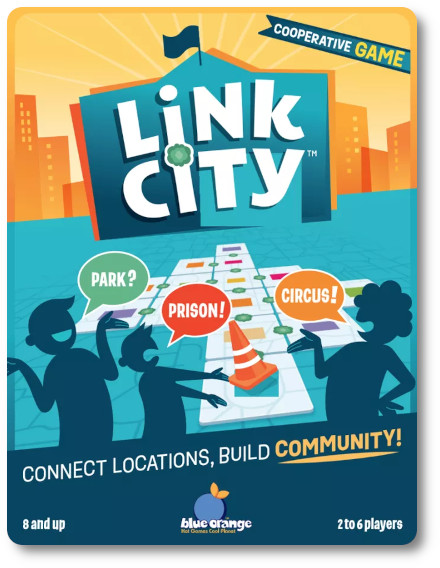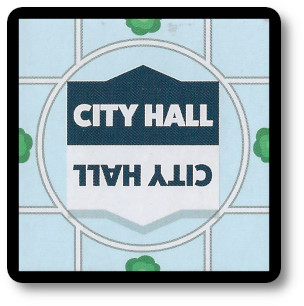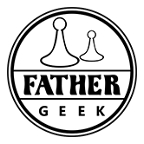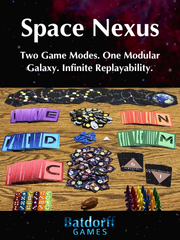 The Basics:
The Basics:
- For ages 8 and up
- For 2 to 6 players
- Approximately 30 minutes to complete
Geek Skills:
- Active Listening & Communication
- Counting & Math
- Logical & Critical Decision Making
- Reading
- Cooperative & Team Play
- Hand/Resource Management
Learning Curve:
- Child – Easy
- Adult – Easy
Theme & Narrative:
- Build a thriving city together, despite having communication challenges
Endorsements:
- Child Geek approved!
- Parent Geek approved!
- Gamer Geek approved!
Overview
Herb Caen, a San Francisco humorist and journalist, whose daily column of local goings-on and insider gossip, social and political happenings, and offbeat puns and anecdotes, said, “A city is not gauged by its length and width, but by the broadness of its vision and the height of its dreams.” In this game, you and your friends will cooperatively build a city of epic proportions. Each turn, a new player assumes the responsibility of expanding the city’s size and grandeur. Just be sure that everyone at the table is on the same page, or your next city project could be a disaster!
Link City, designed by Émilien Alquier and published by Blue Orange Games, is comprised of one City Hall tile, eight Construction tiles, 57 Location tiles, one City Hall screen, four Construction cones, and six Bonus tiles. The tiles are made of thick cardboard and are very durable. The cones are made of solid plastic. The artwork is minimal, with an emphasis on the readability of each tile to ensure that no one at the gaming table is lost.
Prepping for City Planning
To set up the game, follow these steps.
First, separate the Bonus tiles from the Location tiles and place them in a stack off to one side of the game playing area.
Second, place the “City Hall” tile in the center of the playing area, within easy reach of all players.

Third, place all the remaining Location tiles in the game box lid, which will be used as the draw pile. Randomly draw three Location tiles and place them orthogonally connected to the “City Hall” tile. This marks the beginning of the players’ City, where everyone will collectively and cooperatively strive to build the most beautiful city in the world’s history.
Fourth, determine which player will be the “Mayor” for the first round of gameplay. Give this player the Mayor screen and have them draw three Location tiles, which will be immediately placed behind the Mayor screen. The Mayor should keep these Location tiles hidden from their opponents. In addition to the Location tiles, the Mayor should collect and place the three Construction Site tiles behind their Mayor screen.
Let’s Build a City!
Link City is played in turns and rounds, with a set number of six rounds per game. A game round is summarized here.
Step One: Deputy Mayor Takes Their Turn
The player to the left of the Mayor has the title of “Deputy Mayor.” The Deputy Mayor player takes the first turn of the round.
The first action the Deputy Mayor takes on their turn is to set the three Cones to three different locations of their choice to any space where a Location tile could be placed legally. Location tiles can only be placed adjacent to or orthogonally to a previously placed Location tile. The Cones indicate a possible build site for a Location tile currently behind the Mayor’s screen.
Step Two: Mayor Assigns Locations to Cones
The Mayor, in secret behind their Mayor screen, now pairs one Location tile they previously drew with one Cone tile. The Mayor’s goal here is to pair Cones with Location tiles properly so that they believe the other players will place them in the correct location indicated by the Deputy Mayor. Flip the Cone tiles over so they are not visible once they are paired with a Location tile.
Step Three: Reveal and Place
The Mayor now removes their Mayor screen, revealing a row of visible Location tiles that are paired with face-down Cone tiles. All of the players, except the Mayor, now determine where the three Location tiles should be placed.
Each Location tile can only be placed to one of the three spaces marked with a Cone. The goal is to put the Location tiles in the Cone area that would best enhance a beautiful city. For example, the available tiles could include an “Alien Abduction Site.” One of the Cones is next to a “Research Lab” Location tile, and another is next to a “Swimming Pool” Location tile. The players decide that the best location for the “Alien Abduction Site” would be by the Research Lab.

Keep in mind that at all times, while the players place the Location tiles, the Mayor must remain silent and not provide any guidance or make any indication that a Location tile is placed correctly or incorrectly.
Step Four: Reveal and Resolve
After all three Location tiles are matched with a face-up Cone tile, the Mayor reveals their Cone tiles, and the group determines if they have made the correct placement choices.
If the Cone tiles match, the Mayor takes the Location tile, places it in the City, and removes the Cone. By doing so, the players have created one or more “Tree” icons, with each completed icon giving the players a single point.
If the Cone tiles do not match, the Mayor takes the Location tiles and places them wherever they like in the City, but it must be placed diagonally to a previously placed Location tile, ensuring it does not complete a “Tree” icon.
This completes one round of gameplay.
Next Rounds, White Cones, and Bonuses
A new round now begins with the previous Deputy Mayor becoming the new Mayor. The steps during the last round are now repeated. Continue to start and end rounds until a total of six rounds have been completed.
The white Cone and Cone tile come into play if each of the three Location tiles selected by the Mayor is placed correctly. The Bonus tiles are also awarded. The current Mayor takes one of the available Bonus tiles of their choice and adds it to the City, granting the players additional points.
Ending the Game
The game comes to an end after the sixth round is completed. Points are now counted.
Each completed “Tree” icon awards the players one point. Once the total number of trees is determined, the player compares their score to the game’s predetermined level of victory. Ultimate victory is awarded to the players if they have earned 60 or more points.
Game Variant
Each of the Location tiles is double-sided, with a different name on each side. This is intentional as it allows younger players to select the side they want to place when they are the Mayor. For example, there is a Location tile with the title of “Tattoo Parlor” on one side and ‘Park” on the other. Most likely, and I’m just guessing here, the Child Geek Mayor would have an easier time deciding where best to place the Park rather than identifying a proper zone for a Tattoo Parlor. Child Geek or not, both sides of the Location tiles are available to everyone.
To learn more about Link City, visit the game’s webpage.
Final Word
 The Child Geeks enjoyed themselves, finding it not only fun to build the City, but also to tell stories and make passionate arguments about why some Location tiles are perfect and others should be discarded forever. According to one Child Geek, “What I like about the game is how you have to work with others. You have to think like them and make choices that make sense instead of just planning where tiles should go in your head.” Another Child Geek reported, “What I like most about the game is how the City comes to life in front of you, building neat new locations each time. Sometimes the locations are funny, and I don’t like where they are placed because it doesn’t make sense. Most of the time, I do, and I always cheer when we place the tile correctly!” When the City was finished, the Child Geeks took a vote and all decided that Link City was a great place to visit.
The Child Geeks enjoyed themselves, finding it not only fun to build the City, but also to tell stories and make passionate arguments about why some Location tiles are perfect and others should be discarded forever. According to one Child Geek, “What I like about the game is how you have to work with others. You have to think like them and make choices that make sense instead of just planning where tiles should go in your head.” Another Child Geek reported, “What I like most about the game is how the City comes to life in front of you, building neat new locations each time. Sometimes the locations are funny, and I don’t like where they are placed because it doesn’t make sense. Most of the time, I do, and I always cheer when we place the tile correctly!” When the City was finished, the Child Geeks took a vote and all decided that Link City was a great place to visit.
 The Parent Geeks were also enthusiasts of the game, finding it to be fast-paced, casual, and highly engaging for everyone at the table. More than once, a single game turn would end with a heated debate over proper placement and decisions made, but never were any accusations made with the intent of making the Mayor feel poorly. Even if the tiles were placed incorrectly, everyone knew they were collectively at fault and would be rewarded accordingly. This drove home the importance of cooperation and communication before each round. As one Parent Geek put it, “This game forces you to think like others without having to stop thinking for yourself. I love that I had to look at the City like my youngest son one round and as my husband on the next. Entertaining.” Another Parent Geek said, “A great game for the family and with friends. Enjoyed every moment of it, even when we placed a tile incorrectly.” When the City was fully built, the Parent Geeks took a vote and all agreed Link City was a masterpiece.
The Parent Geeks were also enthusiasts of the game, finding it to be fast-paced, casual, and highly engaging for everyone at the table. More than once, a single game turn would end with a heated debate over proper placement and decisions made, but never were any accusations made with the intent of making the Mayor feel poorly. Even if the tiles were placed incorrectly, everyone knew they were collectively at fault and would be rewarded accordingly. This drove home the importance of cooperation and communication before each round. As one Parent Geek put it, “This game forces you to think like others without having to stop thinking for yourself. I love that I had to look at the City like my youngest son one round and as my husband on the next. Entertaining.” Another Parent Geek said, “A great game for the family and with friends. Enjoyed every moment of it, even when we placed a tile incorrectly.” When the City was fully built, the Parent Geeks took a vote and all agreed Link City was a masterpiece.
 The Gamer Geeks were skeptical. After I showed them the game and explained the gameplay, they didn’t think the game would hold their interest for very long. They were wrong. Link City challenged their collective “groupthink” and quickly brought to their full attention their need to communicate more effectively. As one Gamer Geek put it, “What I always find interesting about cooperative games is how easily I forget I am not in competition with my fellow players. You need to be sure you are not too clever in this game and make rational and easy-to-identify choices. That is, in and of itself, damn hard with my group. They all think they are smarter than the others, which will lead you to being too focused on your ideas instead of the other players. Don’t do that. You’ll lose.” Another Gamer Geek loudly exclaimed, “Oh, hell yes! This game was a great hit at our table, serving as both a game filler and an icebreaker. It put all of my players in the mood to play more games and immediately gave everyone creative energy. Great stuff!” At long last, with the City finally complete, the Gamer Geeks took a vote and all agreed that Link City was worthy of their time and praise.
The Gamer Geeks were skeptical. After I showed them the game and explained the gameplay, they didn’t think the game would hold their interest for very long. They were wrong. Link City challenged their collective “groupthink” and quickly brought to their full attention their need to communicate more effectively. As one Gamer Geek put it, “What I always find interesting about cooperative games is how easily I forget I am not in competition with my fellow players. You need to be sure you are not too clever in this game and make rational and easy-to-identify choices. That is, in and of itself, damn hard with my group. They all think they are smarter than the others, which will lead you to being too focused on your ideas instead of the other players. Don’t do that. You’ll lose.” Another Gamer Geek loudly exclaimed, “Oh, hell yes! This game was a great hit at our table, serving as both a game filler and an icebreaker. It put all of my players in the mood to play more games and immediately gave everyone creative energy. Great stuff!” At long last, with the City finally complete, the Gamer Geeks took a vote and all agreed that Link City was worthy of their time and praise.
 Link City is a highly entertaining cooperative tile-placing game that keeps everyone involved from start to finish. As a group, planning must be as precise as possible, without compromising its clarity or obviousness. A number of times, a Location tile or two didn’t seem like a good fit at any of the cones, but careful consideration and a lot of group discussion eventually made the choices a bit clearer. The result is a game that feels highly cooperative, genuinely challenging, highly creative, and immensely satisfying for all who joined us at our gaming table.
Link City is a highly entertaining cooperative tile-placing game that keeps everyone involved from start to finish. As a group, planning must be as precise as possible, without compromising its clarity or obviousness. A number of times, a Location tile or two didn’t seem like a good fit at any of the cones, but careful consideration and a lot of group discussion eventually made the choices a bit clearer. The result is a game that feels highly cooperative, genuinely challenging, highly creative, and immensely satisfying for all who joined us at our gaming table.
If you are looking for a game where planning as a group is a real challenge and a fun one at that, look no further than Link City. I have no doubt you’ll build some great memories.
This game was given to Father Geek as a review copy. Father Geek was not paid, bribed, wined, dined, or threatened in vain hopes of influencing this review. Such is the statuesque and legendary integrity of Father Geek.



